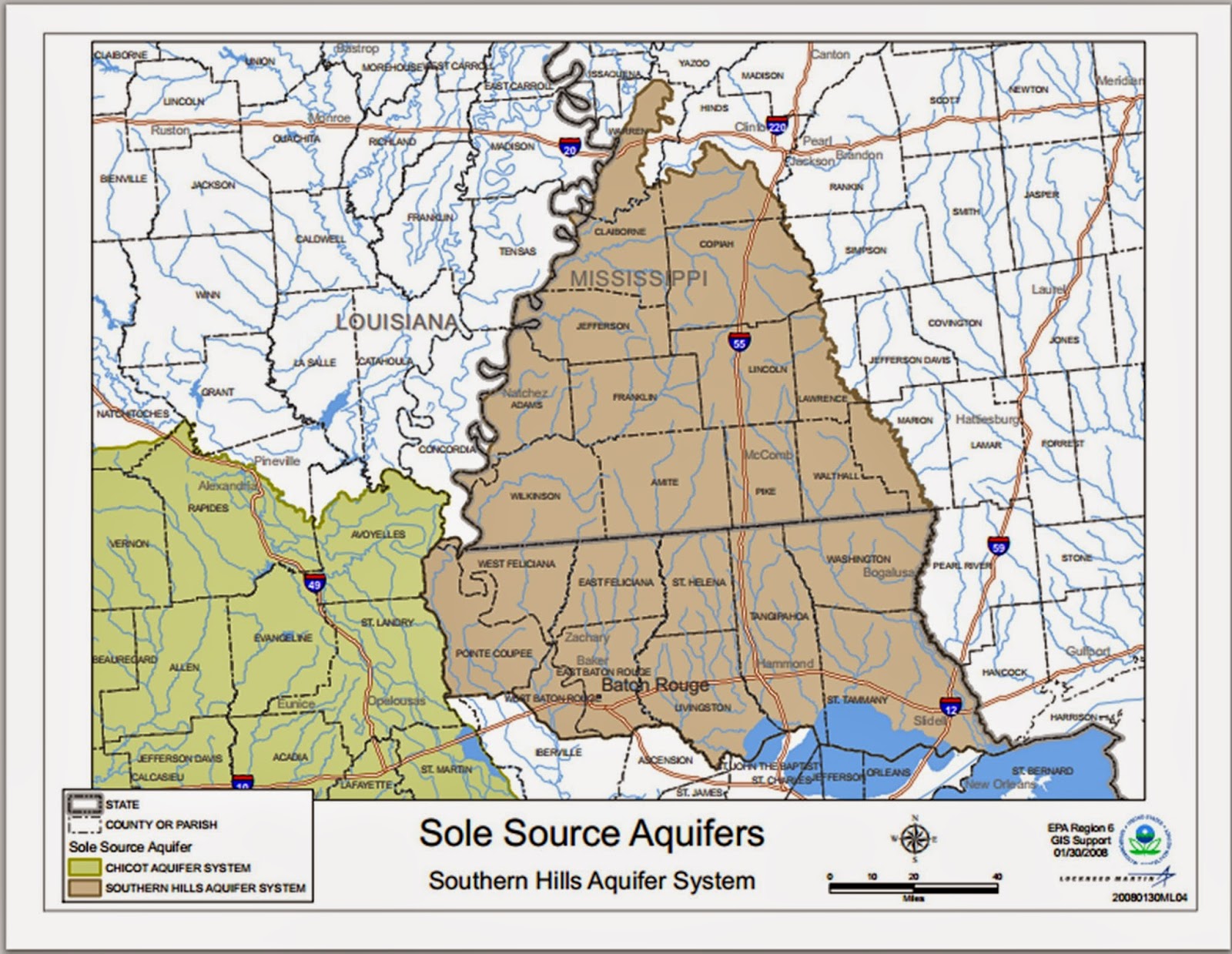Many areas of Louisiana easily rely on surface water, in rivers and streams, for their drinking water needs. But this isn't so for a number Louisiana residents. An estimated 69% of the population of the state relies on groundwater for domestic use, and the same is true for much of southeastern Louisiana. A survey performed as part of a House Resolution this year showed that only a little over half of the people surveyed knew that their water came from a single source, the Southern Hills Aquifer system. The Southern Hills aquifer is the sole source of water for 10 southeastern Louisiana parishes (including East and West Baton Rouge, East and West Feliciana, St. Tammany, St. Helena, Livingston, Tangipahoa, Washington, and Point Coupee), as well as 14 of 17 Mississippi counties that access the aquifer (including Adams, Amite, Claiborne, Copiah, Franklin, Hinds, Jefferson, Jefferson Davis, Lawrence, Lincoln, Marion, Pike, Rankin, Simpson, Warren, Walthall, and Wilkinson). In 1980, the aquifer served over a million people in Louisiana and Mississippi an average of 146 million gallons of water every day. It was projected in 1983 that by 2000 the aquifer would serve 1.5 million people about 220 million gallons of water every day.
The Save BR Water website describes the water from the Southern Hills Aquifer as "amongst the top in the world... long advertised... as being the best and purest. Far from an idle boast, our claim to this premium water is a scientific fact based on [the] location atop a unique geological formation called the Southern Hills Aquifer." The aquifer rangest in depth reaching over 2,500 feet deep, composed of many layers of sand and gravel alongside clay layers from 100-300 feet in depth. The deepest parts of the aquifer were formed 2-3 million years ago. As our ample rain falls, it works its way through the soil and the earth, slowly filtering out all impurities, until finally it reaches the aquifer.
When the USGS studied the Southern Hills Aquifer in 1983, they identified several major streams in southeastern Louisiana, the only alternatives should the aquifer become undrinkable. These rivers include the Amite, Tickfaw, Natalbany, Tangipahoa, Bogue Chitto, Atchafalaya and Pearl Rivers. Although the Pearl River borders St Tammany, and The Bogue Chitto crosses a small bit of the northeastern corner, none of these rivers really run through the parish. The Mississippi, Atchafalaya and Pearl Rivers are the three major rivers, moving between 10,000 gallons per second (Pearl) and 550,000 gallons of water per second (Mississippi). All the other mentioned streams move less than one-fifth of what the Pearl carries. These water sources aren't used because of the added expense of cleaning the water to make it drinkable, as well as the difficulty and expense of distributing this water (you can't just build a well). "Ground water, on the other hand, is available from wells located in the vicinity of the users and can be delivered at nearly half the cost of river water when considering water treatment alone." The USGS estimated that groundwater from Baton Rouge cost 10 cents less per 1,000 gallons than the treated river water of New Orleans (12 cents per 1,000 gallons in BR versus 22 cents per 1,000 gallons in NO). "Using surface water would nearly double the cost to users, based on the required water treatment alone." Further, threats to the river, such as chemical spills, can threaten to entirely disrupt the water supply. It's estimated that 66-70% of the water used in Baton Rouge alone goes to industrial use in paper mills and a variety of other industries, who rely on clean water.
Salt water intrusion, caused by over-pumping wells and drawing saltwater from across the Baton Rouge fault into the freshwater of the aquifer, has been threatening the aquifer for decades, with chloride levels rising by over 300% between 1975 and 1990. Other naturally occurring dissolved compounds, like iron, threaten to make the aquifer undrinkable as well. But it's the increasing threat of contamination from surface and other activities, including the new threat of fracking, that we can control. "We must deman a long-term sustainable solution for the benefit of future generations! It is the responsibility of our State Government to protect our fresh ground water now and for the future..."
Map source: http://www.epa.gov/region6/water/swp/ssa/maps/ssa_shills.pdf
USGS survey: http://pubs.usgs.gov/wri/1983/4189/report.pdf
Save BR Water: http://www.savebrwater.com/goodwater.html
Related Articles:
House Concurrent Resolution No. 52
http://www.legis.la.gov/Legis/ViewDocument.aspx?d=887779
A New Tool Arrives to Fight Saltwater Intrusion
http://theadvocate.com/home/6496152-125/new-tool-arrives-to-fight
Louisiana Water Quantity and Policy-
http://srwqis.tamu.edu/louisiana/program-information/louisiana-target-themes/water-quantity-policy/
Louisiana Ground-Water Quality-
http://www.ngwa.org/Documents/States/GWQ/GWQ_Louisiana.pdf

thank you, Kristin.
ReplyDeleteyou're welcomed :)
ReplyDelete